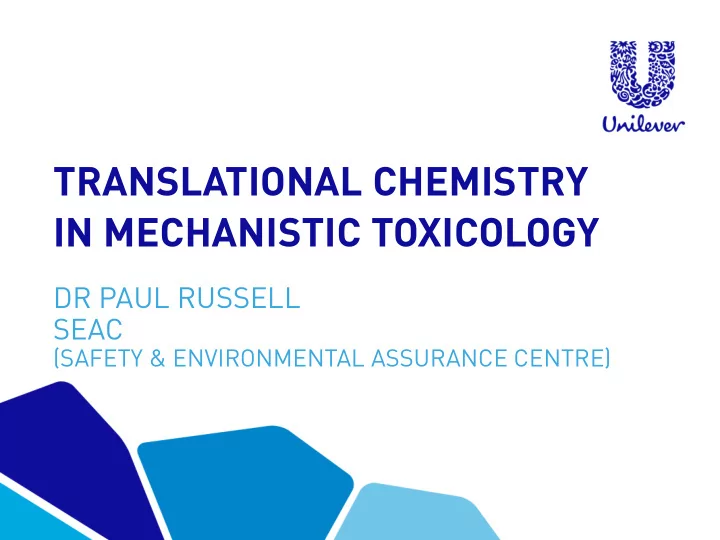

TRANSLATIONAL CHEMISTRY IN MECHANISTIC TOXICOLOGY DR PAUL RUSSELL SEAC (SAFETY & ENVIRONMENTAL ASSURANCE CENTRE) Unilever Information: Internal Use
Analytical Mechanistic Understanding Predictive SEAC 2 Unilever Information: Internal Use
• Matrix • Biological geography • Tertiary structure • Exposure • Dynamic system
ANALYTICAL CHEMISTRY – DRIVING CHANGE 1920’s Accessibility Sensitivity Today SEAC Unilever Information: Internal Use 1920s Today
CHEMICAL CHARACTERISATION Structure • HPLC • GC • UV Purity • MS • FTIR • NMR • CE Physical chemical properties • ELISA SEAC Unilever Information: Internal Use
CHARACTERISING CHEMICAL-BIOLOGICAL INTERACTIONS Rate of interaction is critical to understanding effect k’ k’’ Biological Response Adversity Adaption Time Mechanistic understanding of molecular initiating events (MIEs) using NMR spectroscopy; Sanderson, P.N et al ; Toxicology Research; 5 (2016); 34-44
PEPTIDE REACTIVITY Adduct Formation Assay Kinetics Assay Products of reactions of test Rate of reaction between test chemical and synthetic peptides chemical and synthetic peptides studied by LC-MS studied by fluorescence spectrometry • Confirm mechanism • Compare relative reactivity • Select read across candidates • Provide a surrogate value for in • Provide input into vivo reactivity in mathematical mathematical models (e.g models (e.g. skin allergy) skin allergy) Structure Kinetic Rate 3.0 -06 mM -1 s -1 2.3 -06 mM -1 s -1 1.8 -05 mM -1 s -1 Example – relative reactivity of gamma lactams Example – reactivity of MIT SEAC 7 Unilever Information: Internal Use
METABOLOMICS R&D - SEAC
CONSIDERING CONCENTRATION AT TARGET IN VITRO In vitro to in vivo extrapolation * Additional interactions introduced by in-vitro assays compared to an in-vivo system. Emphasis should be placed on understanding the free concentration available to reach the target and have an effect. SEAC Unilever Information: Internal Use Gutsell, S., Russell, P.J.; Toxicology Research; 2 (2013); 229-307
FREE CONCENTRATION MEASUREMENTS Ultracentrifugation Rapid Equilibrium Dialysis Solid Phase Microextraction (SPME) Buffer chamber Sample chamber 8K MWCO Membrane Ultrafiltration SEAC Unilever Information: Internal Use
COMPUTATIONAL CHEMISTRY Predictions of: bond angles/lengths (geometry) • charges • orbital energies • heat of formation • Torsion angle ≈ 0 º activation energies • volume/surface area • pKa • logP • Hydrogen Bonding etc etc •
Atomic Charge
Binding of 4-Nonylphenol to the estrogen receptor β
Binding of β -Sitosterol to the glucocorticoid receptor
MECHANISTIC CHEMISTRY AND STRUCTURAL ACTIVITY RELATIONSHIPS By linking an MIE to effects at any organisational level, we may not need to understand subsequent parts of the pathway Understanding the molecular interactions at the MIE allows reliable predictions which have less variability brought in by subsequent complex biological networks Source Environmental Exposure Molecular Organelle/ Cellular Tissue Organ Organ Individual Population Community Containment Initiating Molecular Effects Effects Effects Systems Effects Effects Effects Event Assemblies Effects Effects Molecule to molecule Complex biology
METABOLISM Prediction Measurement SEAC 16 Unilever Information: Internal Use
PHYSIOLOGICALLY BASED KINETIC MODELLING PBK modelling can help identify target organs of concern Knowledge of physical chemical properties is critical SEAC Unilever Information: Internal Use
MOLECULAR DYNAMIC MODELLING Measurement Prediction SEAC Unilever Information: Internal Use
MODEL-BASED, NON-ANIMAL APPROACH FOR SKIN SENSITIZATION RISK ASSESSMENT Objective : mathematical model scope should be simplest representation of the chemistry and biology capable of reproducing the induction of contact allergy to enable prediction of a safe level of skin exposure (i.e. to inform risk assessment) SEAC Unilever Information: Internal Use
TRANSLATION ‘The conversion of something from one form or medium into another’ Data Knowledge Problem Solving SEAC Unilever Information: Internal Use
THE MOLECULAR INITIATING EVENT (MIE) Source Environmental Exposure Molecular Cellular Tissue Organ Organ Individual Population Community Organelle/ Containment Initiating Effects Effects Effects Systems Effects Effects Effects Molecular Event Effects Assemblies Effects An MIE is the initial interaction between a molecule and a • biomolecule or biosystem that can be linked to an outcome via a pathway Different MIEs can lead to the same Adverse Outcome • Pathway (AOP) Most chemicals can interact with more than one target • with different affinities and effects Allen, T.E., Goodman, J.M., Gutsell, S., Russell, P.J.; Chemical Research in Toxicology; 27 (2014); 2100-2112
WHAT DRIVES AN MIE? 3D structure & Steric effects Physchem properties Exposure MIE Systemic location Metabolism Individuals (variance, susceptibility)
SUMMARY Chemistry is fundamental to understand how molecules interact with biology • Analytical measurements • Computational predictions Translating the chemistry into meaningful information requires a collaborative, cross-disciple approach Mathematical Toxicologists Chemists Modellers Informaticians Biologists
THANK YOU ANY QUESTIONS?
EXPOSURE MEASUREMENTS • Measurement of free concentrations and binding • Environmental and biological sampling SEAC 25 Unilever Information: Internal Use
Recommend
More recommend